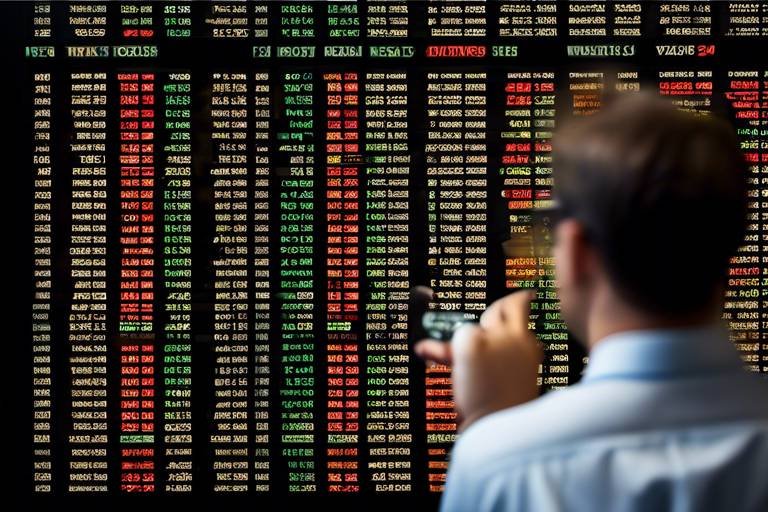How to Analyze Historical Market Trends for Better Trading
In the ever-evolving world of trading, understanding historical market trends is not just a luxury; it’s a necessity. Think of market trends as the roadmaps guiding traders through the often turbulent waters of financial markets. By analyzing these historical trends, traders can make more informed decisions, identify potential opportunities, and ultimately enhance their trading strategies. Whether you’re a novice just starting out or an experienced trader looking to refine your approach, mastering the art of trend analysis can be a game changer. So, let’s dive into the fascinating world of market trends and discover how you can leverage them to your advantage.
Market trends are the lifeblood of trading. They represent the general direction in which prices are moving, and recognizing them can significantly inform your trading decisions. There are three primary types of market trends: bullish, bearish, and sideways. A bullish trend indicates rising prices, a bearish trend signifies declining prices, and a sideways trend reflects a period of price stagnation. Understanding the characteristics of each trend can help you determine when to enter or exit a position. For instance, during a bullish trend, traders might look for opportunities to buy, while in a bearish market, short-selling could be more favorable. By keeping an eye on these trends, you can position yourself strategically in the market.
To analyze historical market trends effectively, you need reliable data sources. The quality of your analysis is only as good as the data you use. Various platforms offer historical market data, including trading platforms, financial news websites, and specialized data services. Some of the most popular sources include:
- Yahoo Finance - Offers extensive historical data on stocks, ETFs, and indices.
- Google Finance - Provides historical price data and financial news.
- Bloomberg - Known for in-depth financial analysis and market data.
By utilizing these platforms, traders can gather the necessary data to support their trading decisions and strategies.
Financial news archives are treasure troves of information that can provide valuable insights into past market reactions. By sifting through archived news articles, traders can gain a better understanding of how specific events influenced market movements. For example, analyzing how the market reacted to major economic announcements or geopolitical events can help you anticipate future reactions. It’s like piecing together a puzzle; each article adds a new dimension to your understanding of market behavior.
Economic indicators are critical in understanding market movements. These indicators, such as GDP growth rates, unemployment rates, and inflation figures, can significantly influence trading decisions. Monitoring key indicators can help traders identify potential market shifts before they happen. For instance, a sudden increase in unemployment rates might signal an impending economic downturn, prompting traders to adjust their strategies accordingly. By keeping a close eye on these indicators, you can enhance your predictive analysis and make more informed trading decisions.
Market reports and studies offer in-depth analyses of historical performance. These resources can provide context for price movements and help traders understand the underlying factors driving market behavior. By leveraging these reports, traders can gain a comprehensive understanding of how markets have reacted to various stimuli over time. This knowledge not only aids in current decision-making but also helps in crafting long-term trading strategies that are resilient to market fluctuations.
Technical analysis is a powerful tool that involves studying price charts and patterns to predict future market movements. By analyzing historical data, traders can identify trends and patterns that may not be immediately apparent. Techniques such as moving averages, trend lines, and candlestick patterns can provide valuable insights into market behavior. For instance, a trader might use moving averages to identify the overall direction of a market trend, while candlestick patterns can reveal potential reversal points. Mastering these techniques can significantly enhance your ability to interpret historical data and make informed trading decisions.
Recognizing patterns and cycles in historical data is crucial for developing effective trading strategies. Market behavior often exhibits recurring patterns that can signal future movements. For example, the head and shoulders pattern is a well-known indicator of market reversals, while double tops and double bottoms can indicate potential trend changes. Understanding these patterns can give traders a significant edge in anticipating market movements and making timely decisions.
Seasonal trends can have a profound impact on market behavior. Certain assets may perform better during specific times of the year due to various factors, such as consumer behavior or weather conditions. By analyzing historical data for seasonal patterns, traders can identify opportunities to capitalize on these trends. For instance, retail stocks often see increased activity during the holiday season, making it an ideal time for traders to invest in these companies.
Charting historical data is one of the most effective ways to visualize trends and identify potential trading opportunities. Various charting techniques, such as line charts, bar charts, and candlestick charts, can help traders interpret price movements over time. By visually representing historical data, traders can easily spot trends, patterns, and anomalies that may influence their trading decisions. It’s like having a crystal ball that reveals the past to help you navigate the future.
Q: How can I start analyzing historical market trends?
A: Begin by familiarizing yourself with the different types of market trends and the data sources available. Utilize platforms like Yahoo Finance or Bloomberg to gather historical data, and practice identifying trends in various markets.
Q: What are some common mistakes to avoid in trend analysis?
A: Common mistakes include relying on incomplete data, ignoring economic indicators, and failing to consider market sentiment. Always use multiple data sources and stay informed about broader market conditions.
Q: How often should I analyze market trends?
A: Regular analysis is essential. Depending on your trading style, you may want to review trends daily, weekly, or monthly to stay ahead of market movements.

Understanding Market Trends
Market trends are the backbone of trading strategies, and understanding them can be the difference between making a profit and taking a loss. Imagine trying to navigate a ship without knowing the direction of the wind; that's what trading without recognizing market trends feels like. Essentially, there are three primary types of market trends: bullish, bearish, and sideways. Each of these trends provides critical insights that can inform your trading decisions.
A bullish trend indicates a period where prices are rising or expected to rise. In this scenario, traders tend to feel optimistic, leading to increased buying activity. Think of it as climbing a hill; the higher you go, the more exhilarating the view becomes. Traders often look for signals that suggest this upward momentum will continue, such as strong earnings reports or positive economic indicators.
On the flip side, a bearish trend represents a decline in prices, where traders are more pessimistic. Picture a roller coaster that’s descending rapidly; the thrill is replaced with anxiety. During a bearish trend, traders may seek to sell off assets to avoid losses, often relying on indicators like rising unemployment rates or declining consumer confidence to confirm their fears.
Then, there’s the sideways trend, where prices move within a narrow range, showing little to no directional movement. It’s like being stuck in traffic; you’re not going forward or backward, just waiting for something to change. In this type of market, traders often adopt a wait-and-see approach, looking for breakout opportunities that could signal a shift to either a bullish or bearish trend.
Recognizing these trends is crucial for traders of all experience levels. It allows you to make informed decisions about when to enter or exit trades. For instance, if you spot a bullish trend, it might be a good time to buy, while a bearish trend could signal a time to sell or short-sell. But how do you spot these trends?
One effective way is through the use of technical analysis, which involves analyzing price charts and identifying patterns. Traders often look for specific indicators like moving averages or the Relative Strength Index (RSI) to confirm the trend's strength. Additionally, keeping an eye on market sentiment—how other traders feel about the market—can provide valuable context.
In summary, understanding market trends is not just about recognizing whether prices are going up or down; it's about interpreting the underlying factors that drive these movements. By being aware of the different types of trends and how they manifest, you can enhance your trading strategies and make more informed decisions. So, the next time you consider a trade, ask yourself: what trend is the market showing, and how can I leverage that to my advantage?

Data Sources for Historical Analysis
When it comes to analyzing historical market trends, having the right data sources at your fingertips is essential. Think of it like trying to solve a mystery; without the right clues, you might end up going in circles. Traders need to tap into reliable platforms and tools that provide comprehensive historical market data. This not only aids in making informed decisions but also helps to build a robust trading strategy based on solid evidence rather than mere speculation.
There are several types of data sources available for traders looking to conduct historical analysis. Some of the most prominent include:
- Brokerage Platforms: Many brokerage firms offer their clients access to historical data as part of their trading platforms. This data often includes price charts, trading volumes, and other essential metrics.
- Financial News Websites: Websites like Bloomberg, Reuters, and CNBC provide not only current news but also archives of past articles that can help traders understand market reactions to historical events.
- Market Data Providers: Companies such as Quandl and Yahoo Finance offer extensive databases filled with historical stock prices, indices, and economic data that can be invaluable for traders.
By utilizing these sources, traders can create a more accurate picture of past market behaviors, leading to better predictions of future trends. For instance, a trader analyzing stock performance over the last decade can identify periods of significant growth or decline, which can be pivotal in making future investment decisions. Additionally, understanding how external factors like economic crises or political events influenced market movements can provide context that raw data alone cannot.
One of the most underrated resources for historical market analysis is the financial news archives. These archives are treasure troves of information, offering insights into how markets reacted to specific events in the past. For example, if a trader wants to understand how the market responded to the 2008 financial crisis, they can sift through articles from that time to gather insights. By analyzing the sentiment and predictions made by experts, traders can gain a clearer understanding of the market psychology during significant downturns.
Another critical aspect of historical analysis involves monitoring economic indicators. These indicators, such as GDP growth rates, unemployment rates, and inflation rates, serve as barometers for market health. Traders should pay close attention to these indicators, as they can significantly influence market movements. For example, a sudden spike in unemployment rates could lead to bearish market sentiments, while a consistent rise in GDP could signal bullish trends. Understanding these indicators can help traders anticipate market shifts before they happen.
In addition to news articles and economic indicators, market reports and studies provide in-depth analyses of historical performance. Many financial institutions and research firms publish detailed reports that analyze trends over specific periods. These reports often include valuable information such as sector performance, historical volatility, and investor sentiment. By leveraging these resources, traders can gain a comprehensive understanding of market behavior over time, which is crucial for developing effective trading strategies.
Lastly, employing technical analysis techniques is vital for interpreting historical data effectively. Traders can study price charts and patterns to identify trends and potential reversal points. Techniques such as moving averages, trend lines, and candlestick patterns can help traders visualize historical data, making it easier to spot opportunities in the market.

Financial News Archives
When it comes to analyzing historical market trends, one of the most underutilized yet powerful resources is the financial news archive. Imagine having a time machine that allows you to revisit the market's reaction to significant events. That's precisely what these archives offer! By diving into past news articles, traders can uncover the emotional and psychological factors that drove market movements during critical moments.
But how do you effectively utilize these archives? First, consider the major events that have historically influenced the markets. For example, economic crises, changes in government policy, and global events like natural disasters or pandemics can create ripples that affect market behavior. By sifting through archived articles from reputable financial news sources, traders can gain insights into how the market reacted to these events. Did it plummet? Did it soar? Understanding these reactions can provide a clearer picture of potential future movements.
Moreover, financial news archives can help traders identify trends in market sentiment. For instance, if you notice a consistent pattern of negative sentiment following specific types of news, you might adjust your trading strategy accordingly. To make this process easier, consider using a structured approach:
- Identify Key Events: Focus on significant news events that impacted the market.
- Analyze Market Reactions: Look for patterns in how the market responded to these events.
- Correlate with Historical Data: Compare the news with historical price movements to identify trends.
Incorporating this analysis into your trading strategy can be a game-changer. It’s like having a secret weapon in your trading arsenal, allowing you to predict potential market shifts based on historical reactions. Just remember, while history can provide valuable insights, it’s not a crystal ball. Always combine your findings with other analysis techniques to make well-rounded trading decisions.
In summary, financial news archives serve as a treasure trove of information that can enhance your trading strategies. By understanding how the market has reacted to past events, you can better anticipate future movements, ultimately leading to more informed trading decisions. So, the next time you’re analyzing historical trends, don’t overlook the power of a good news archive!
- What are financial news archives? Financial news archives are collections of past news articles that cover significant market events and trends.
- How can I access financial news archives? Many financial news websites offer archives, and some platforms specialize in aggregating historical financial data.
- Why are financial news archives important for trading? They provide insights into how the market has reacted to past events, helping traders make informed decisions.

Economic Indicators
When it comes to trading, understanding is like having a secret map that guides you through the unpredictable landscape of the market. These indicators are vital statistics that reflect the economic health of a country, and they can significantly influence market movements. You might wonder, how do these numbers affect my trading decisions? Well, think of economic indicators as the pulse of the economy; when you know the pulse, you can anticipate changes and make informed decisions.
Some of the most crucial economic indicators include Gross Domestic Product (GDP), unemployment rates, inflation rates, and consumer confidence indexes. Each of these indicators provides unique insights into the economic environment:
| Indicator | Description | Impact on Market |
|---|---|---|
| GDP | The total value of goods and services produced in a country. | A rising GDP typically indicates a growing economy, which can lead to bullish market trends. |
| Unemployment Rate | The percentage of the labor force that is unemployed and actively seeking employment. | Higher unemployment can signal economic distress, often leading to bearish market sentiment. |
| Inflation Rate | The rate at which the general level of prices for goods and services is rising. | Moderate inflation can be a sign of economic growth, but high inflation may lead to market volatility. |
| Consumer Confidence Index | A measure of how optimistic or pessimistic consumers are regarding their expected financial situation. | High consumer confidence can lead to increased spending, positively impacting market trends. |
By keeping a close eye on these indicators, traders can gain valuable insights into potential market movements. For instance, if the GDP is on the rise, it might be a good time to consider investing in stocks, as a growing economy usually leads to higher corporate profits. On the other hand, a spike in unemployment could signal caution, prompting traders to rethink their strategies.
Moreover, it's essential to recognize that economic indicators do not exist in isolation. They often interact with one another, creating a complex web of influence. For example, a rise in inflation might lead to an increase in interest rates, which could, in turn, dampen consumer spending. Understanding these relationships is key to making sound trading decisions.
In conclusion, economic indicators are not just numbers; they are the heartbeat of the market. By analyzing these indicators, traders can better navigate the tumultuous waters of trading, making decisions that are informed and timely. So, the next time you look at a market chart, remember to check the economic indicators—your trading strategy might just depend on it!

Market Reports and Studies
When it comes to trading, knowledge is power, and one of the most potent sources of knowledge is . These documents provide a wealth of information about historical market performance, offering insights that can be incredibly valuable for traders looking to refine their strategies. Think of market reports as the blueprints of the trading world; they reveal the underlying structures that influence price movements and market behaviors over time.
Market reports typically include detailed analyses of various financial instruments, encompassing equities, commodities, currencies, and more. They often highlight key trends, price movements, and significant events that have shaped the market landscape. By diving into these reports, traders can gain a comprehensive understanding of how specific factors, such as geopolitical events or economic shifts, have historically impacted market conditions.
Moreover, studies conducted by financial analysts and institutions often provide quantitative data that can be crucial for predictive analysis. For instance, consider how a report might illustrate the correlation between interest rate changes and stock market performance. This kind of information allows traders to make more informed decisions, anticipating how future events might mirror past occurrences.
In addition to understanding market movements, these reports can also shed light on investor sentiment. This is particularly important because market trends are often driven by collective emotions and behaviors. By analyzing how previous market participants reacted to certain events, traders can better gauge potential reactions to similar events in the future. For example, if a report indicates that a significant drop in oil prices led to panic selling in the stock market, a trader might prepare for a similar reaction if oil prices plummet again.
To effectively leverage market reports and studies, traders should consider the following:
- Relevance: Ensure the report pertains to the specific market or instrument you are trading.
- Timeliness: Use the most current studies to capture the latest trends and insights.
- Credibility: Rely on reports from reputable sources, such as financial institutions, analysts, or academic studies.
Additionally, many traders find it beneficial to compare multiple reports to identify common trends and discrepancies. This comparative analysis can help in forming a more rounded view of the market, enabling traders to make decisions based on a broader spectrum of information.
In conclusion, market reports and studies are invaluable tools that can significantly enhance a trader's ability to navigate the complexities of the market. By understanding historical performance and the factors that influenced it, traders can develop strategies that not only react to market movements but also anticipate them. So, the next time you’re preparing for a trading session, don’t overlook the power of these reports. They might just hold the key to your trading success.
- What are market reports? Market reports are detailed analyses of market performance that provide insights into trends, price movements, and significant events.
- How can I access market reports? Market reports can be accessed through financial news websites, brokerage firms, and financial institutions.
- Why are market studies important? Market studies help traders understand historical performance, investor sentiment, and potential future market movements.
- What should I look for in a market report? Look for relevance, timeliness, and credibility when selecting market reports to analyze.

Technical Analysis Techniques
When it comes to trading, understanding the past can be your greatest ally, and that’s where come into play. Think of technical analysis as your trading compass, guiding you through the often turbulent waters of market trends. By studying price charts and historical data, traders can identify patterns that may repeat themselves, giving them a crucial edge in decision-making. But how do you effectively harness these techniques? Let’s dive into some of the most effective methods.
One of the foundational techniques in technical analysis is the use of trend lines. By drawing lines that connect significant price points on a chart, traders can visualize the direction of the market—whether it’s moving upwards, downwards, or sideways. This simple yet powerful tool helps in identifying potential support and resistance levels. Imagine standing on a hill, looking down at a winding road; the trend line is your view of the path ahead, allowing you to anticipate turns and obstacles.
Another essential tool is the moving average. This technique smooths out price data over a specified period, helping traders identify the overall direction of the trend. For instance, a 50-day moving average can show you whether the market is generally trending up or down over the past two months. It’s like looking at the weather forecast; while today might be cloudy, the forecast gives you a clearer picture of what to expect in the coming days.
Additionally, traders often use oscillators such as the Relative Strength Index (RSI) or the Moving Average Convergence Divergence (MACD). These indicators help in determining whether a market is overbought or oversold. For example, an RSI above 70 may suggest that a stock is overbought, indicating a potential price correction. Think of these oscillators as your market pulse; they help you gauge the health of your investments and can signal when it might be time to buy or sell.
Now, let’s not forget about volume analysis. Volume refers to the number of shares or contracts traded in a security or market during a given period. By analyzing volume alongside price movements, traders can confirm trends. For instance, if a stock’s price is rising but the volume is low, it may not be a strong upward trend. On the other hand, if the price is increasing with high volume, it’s often a sign of strength. This relationship can be visualized in a simple table:
| Price Movement | Volume Level | Signal |
|---|---|---|
| Price Up | High | Strong Trend |
| Price Up | Low | Weak Trend |
| Price Down | High | Strong Trend |
| Price Down | Low | Weak Trend |
With these techniques in your toolkit, you’re better equipped to analyze historical market data and make informed trading decisions. Remember, the key is not just to rely on one technique but to combine several methods for a more comprehensive view of the market. It’s like having a multi-tool for your trading strategy—each tool serves a purpose, and together, they can help you navigate the complexities of trading with confidence.
Q1: What is technical analysis?
A1: Technical analysis involves studying price movements and historical data to forecast future market behavior. It uses various tools and techniques to identify patterns and trends.
Q2: How can I start using technical analysis?
A2: Begin by familiarizing yourself with basic concepts like trend lines, moving averages, and oscillators. Practice analyzing charts and consider using trading platforms that offer technical analysis tools.
Q3: Is technical analysis better than fundamental analysis?
A3: It depends on your trading style. Technical analysis is great for short-term trading, while fundamental analysis focuses on long-term investment based on a company's financial health. Many traders use a combination of both.

Identifying Patterns and Cycles
When it comes to trading, one of the most powerful tools in your arsenal is the ability to identify patterns and cycles in historical data. Think of it like being a detective, piecing together clues from the past to predict what might happen in the future. Just as a seasoned detective knows that certain behaviors can hint at a suspect's next move, traders who understand market patterns can make more informed decisions. But how exactly do we go about uncovering these patterns?
First, let’s dive into what we mean by patterns. In the trading world, patterns refer to the shapes and formations that price movements create on charts. These can include formations like head and shoulders, double tops, and flags, each telling a story about market sentiment and potential future movements. For example, a head and shoulders pattern often indicates a reversal from bullish to bearish, while a double bottom can signal a potential bullish reversal. Recognizing these patterns can be like having a roadmap in a dense forest; it guides you through the chaos of market fluctuations.
Next up, we have cycles. Unlike patterns that can be more immediate, cycles are about looking at the bigger picture. They represent the recurring periods of market behavior, often influenced by broader economic factors or seasonal changes. For instance, many traders notice that certain stocks tend to perform better during specific times of the year, such as retail stocks during the holiday season. Understanding these cycles can help you time your trades more effectively, much like a surfer waiting for the perfect wave to ride.
To effectively identify these patterns and cycles, traders often rely on a combination of technical analysis tools and historical data. Tools like moving averages, trend lines, and oscillators can help highlight potential patterns that may not be immediately obvious. For instance, a simple moving average can smooth out price data, making it easier to spot upward or downward trends over time. When you overlay this with historical price data, you can start to see how similar conditions played out in the past, giving you a clearer picture of what might happen next.
Additionally, keeping an eye on market sentiment can provide context for the patterns and cycles you identify. Sentiment can be gauged through various means, such as social media trends, news coverage, and even investor surveys. When sentiment aligns with the patterns you’re observing, it can reinforce your trading strategy, providing that extra layer of confidence. Imagine you're at a concert, and the crowd's energy is electric; you can feel the excitement building. That’s the kind of vibe you want to capture in the market as you analyze patterns and cycles.
In conclusion, understanding how to identify patterns and cycles in historical data is essential for enhancing your trading strategies. By combining technical analysis with insights from market sentiment and economic indicators, you can navigate the complexities of the market with greater confidence. Remember, every trader has their unique approach, so take the time to find what resonates with you. With practice and patience, you’ll be able to spot those telltale signs that could lead to successful trades.
- What are the most common trading patterns? Some popular patterns include head and shoulders, double tops and bottoms, and flags.
- How can I identify market cycles? Look for recurring trends over specific time frames and consider seasonal influences.
- What tools can help with technical analysis? Tools like moving averages, trend lines, and oscillators are commonly used to analyze price movements.

Seasonal Trends
When it comes to trading, understanding can be a game changer. Just like the changing seasons affect our daily lives—think of how winter brings snow and summer invites beach days—markets also have their own rhythms that can significantly influence prices. By recognizing these patterns, traders can make more informed decisions, potentially increasing their chances of success. But how do we identify these seasonal trends? Well, it often starts with analyzing historical data over specific timeframes.
For instance, certain stocks or commodities may experience consistent price movements during particular months or seasons. A classic example is the retail sector, which typically sees a spike in sales during the holiday season. This can lead to increased stock prices for companies involved in retail. Similarly, agricultural commodities like corn or wheat often have predictable price movements based on harvest cycles. By studying these historical price patterns, traders can anticipate potential market shifts and adjust their strategies accordingly.
To effectively analyze seasonal trends, traders can utilize a variety of tools and resources. A good starting point is to gather historical price data and create a seasonal chart that highlights price movements over different months or seasons. This visual representation allows traders to easily spot trends and make comparisons. Here's a simple example of what a seasonal chart might look like:
| Month | Average Price of Commodity X |
|---|---|
| January | $50 |
| February | $52 |
| March | $55 |
| April | $58 |
| May | $60 |
| June | $65 |
In this table, you can see how the average price of Commodity X increases as the months progress. By identifying such patterns, traders can make predictions about future price movements and plan their trades accordingly. However, it’s essential to remember that while historical trends can provide valuable insights, they are not foolproof. External factors, such as economic changes or unexpected global events, can disrupt these patterns.
Moreover, it’s wise to combine seasonal analysis with other trading strategies, such as technical analysis or fundamental analysis, to create a more robust trading plan. This holistic approach allows traders to consider multiple factors that may influence the market, ultimately leading to better decision-making. So, the next time you're analyzing a potential trade, take a moment to consider the seasonal trends at play. You might just uncover a hidden opportunity that could set you on the path to success!
- What are seasonal trends? Seasonal trends refer to predictable patterns in market prices that occur during specific times of the year.
- How can I identify seasonal trends? By analyzing historical price data and creating seasonal charts, traders can spot recurring patterns over time.
- Are seasonal trends reliable? While they provide valuable insights, seasonal trends should be considered alongside other analyses, as external factors can influence market behavior.

Charting Historical Data
When it comes to trading, visualizing data can be a game changer. allows traders to see patterns, trends, and potential opportunities that might not be immediately obvious from raw numbers. Imagine trying to find your way in a dense forest; without a map, you're likely to get lost. Similarly, charts serve as your map in the trading world, guiding you through the complexities of market behavior.
There are several types of charts that traders can utilize, each providing unique insights into historical data:
- Line Charts: These are simple yet effective, showing price movements over time. They help traders spot overall trends without the noise of fluctuations.
- Bar Charts: More detailed than line charts, bar charts display the open, high, low, and close prices for a specific time period, giving a fuller picture of market activity.
- Candlestick Charts: Often favored by traders, candlestick charts provide visual cues about market sentiment. Each 'candlestick' represents price movements within a specific timeframe and can indicate bullish or bearish trends.
Choosing the right chart type depends on your trading strategy and the information you want to extract. For instance, if you're looking to identify long-term trends, a line chart might suffice. However, if you want to analyze short-term price action, a candlestick chart could be your best bet.
Moreover, charting software and platforms have advanced significantly, offering various tools to enhance your analysis. Features such as indicators and overlays can provide additional layers of insight. Common indicators include:
- Moving Averages: These smooth out price data to help identify the direction of the trend.
- Relative Strength Index (RSI): This momentum oscillator measures the speed and change of price movements, indicating overbought or oversold conditions.
- Bollinger Bands: These provide a relative definition of high and low prices, helping traders identify volatility and potential price reversals.
Utilizing these tools effectively requires practice and patience. You can start by backtesting your strategies on historical data, which can reveal how your trading decisions would have performed in the past. This is akin to rehearsing for a play; the more you practice, the more confident you become when it’s time for the real performance.
Finally, remember that while charts and historical data are valuable, they should not be your only tools. Combine your charting analysis with fundamental research and market news to create a well-rounded trading strategy. Just like a chef needs multiple ingredients to create a delicious dish, a trader needs various forms of analysis to make informed decisions.
- What is the best chart type for beginners? Line charts are often recommended for beginners due to their simplicity and clarity.
- How can I improve my charting skills? Practice consistently with different chart types and indicators, and consider using demo accounts to test your strategies.
- Are there free tools for charting historical data? Yes, many platforms like TradingView and Yahoo Finance offer free charting tools with various features.
Frequently Asked Questions
- What are market trends and why are they important?
Market trends represent the general direction in which the market is moving, whether up, down, or sideways. Understanding these trends is crucial for traders because they inform decisions about when to buy or sell assets. By recognizing market trends, traders can align their strategies with the prevailing market conditions, increasing their chances of making profitable trades.
- How can I find reliable data sources for historical market analysis?
Reliable data sources for historical market analysis include financial news archives, economic indicators, and market reports. Platforms like Bloomberg, Yahoo Finance, and TradingView offer extensive historical data. Additionally, government websites provide economic indicators that can help traders understand market movements over time.
- What role do economic indicators play in trading?
Economic indicators are statistics that provide insights into the economic performance of a country. They can significantly influence market trends and trader sentiment. By monitoring key indicators such as GDP, unemployment rates, and inflation, traders can better anticipate market movements and adjust their strategies accordingly.
- What are some common technical analysis techniques?
Common technical analysis techniques include trend lines, moving averages, and various chart patterns like head and shoulders or flags. These tools help traders interpret historical price data and forecast future movements by identifying trends and potential reversal points.
- How can I identify patterns and cycles in historical data?
Identifying patterns and cycles in historical data involves analyzing price movements over time to spot recurring trends. Traders often use charting tools to visualize data and look for patterns such as double tops, triangles, or seasonal trends that can indicate future price movements.
- What are seasonal trends and how do they affect trading?
Seasonal trends refer to predictable patterns that occur at certain times of the year, often influenced by factors like holidays or weather changes. Traders can analyze historical data to identify these trends, allowing them to make informed decisions about when to enter or exit trades based on seasonal market behavior.
- What is the importance of charting historical data?
Charting historical data is essential for visualizing market trends and patterns. It allows traders to see price movements clearly, making it easier to identify potential trading opportunities. By using various charting techniques, traders can analyze past performance and make more informed predictions about future market behavior.



















